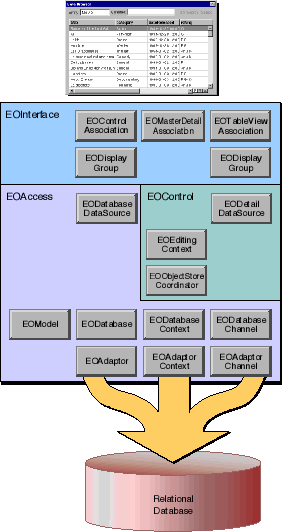 Table of Contents
Table of Contents  Previous Section
Previous Section
Classes in an Application Kit Client/Server Application
An Application Kit client/server application uses an architecture similar to that in a command-line program, but it incorporates classes to synchronize values between enterprise objects and the application's user interface. This section describes the roles of those classes and how they fit into the application's architecture.

Figure 16. Classes in an Application Kit Application
User Interface Objects
In a traditional client/server application such as the one described in this chapter, Application Kit user interface objects (such as NSPopUpButtons, NSForms, NSTextFields, and NSTableViews) are used to display the values of enterprise objects. When values are edited in the user interface, these same Application Kit objects are used to communicate the changes back to the enterprise objects. In Figure 16, Application Kit classes are represented by a screen capture of a real application's user interface.
The Interface Layer
The interface layer in an Application Kit application synchronizes data between the application's user interface (Application Kit objects) and the control layer's graph of enterprise objects. The relationship between user interface objects and enterprise objects is managed by EODisplayGroup objects. More precisely, display groups are used by EOAssociation objects to mediate between enterprise objects and the user interface. EOAssociations link a single user interface object to one or more class properties (keys) of the objects managed by a display group. The properties' values are displayed in the association's user interface object. Access and Control Layers
The roles of the access and control layers in an Application Kit application are the same as they are in a command-line application. However, in an Application Kit application, each layer supplies a data source for interacting with the interface layer.
 Table of Contents
Table of Contents  Next Section
Next Section